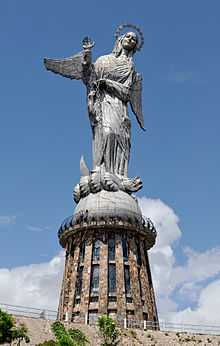El Panecillo

El Panecillo (from Spanish panecillo small piece of bread, diminutive of pan bread) is a 200-metre-high hill of volcanic-origin, with loess soil, located between southern and central Quito. Its peak is at an elevation of 3,016 metres above sea level. The original name used by the aboriginal inhabitants of Quito was Yavirac. According to Juan de Velasco, a Jesuit historian, on top of Yavirac there was a temple which the Indians used to worship the sun. This temple is said to have been destroyed by the Spanish conquistadores. The street that leads up to El Panecillo is called Melchor Aymerich.
Statue

In 1976, the Spanish artist Agustín de la Herrán Matorras was commissioned by the religious order of the Oblates to build a 45-metre-tall stone monument of a madonna which was assembled on a high pedestal on the top of Panecillo. It is made of seven thousand pieces of aluminium. The monument was inaugurated on March 28, 1976, by the 11th archbishop of Quito, Pablo Muñoz Vega. The statue was engineered and erected by Anibal Lopez of Quito.
The virgin stands on top of a globe and is stepping on a snake, which is a classic madonna iconography. Less traditional are the wings. Locals claim that she is the only one in the world with wings like an angel. The monument was inspired by the famous "Virgen de Quito" (Quito's Madonna) also known as "the dancer" sculpted by Bernardo de Legarda in 1734, which now decorates the main altar at the Church of St. Francis. This madonna represents a turning point of the Quito School of Art (one of the most renowned of the Americas) because it shows a virgin in movement that is practically dancing in contrast with the traditional static Madonnas that were produced during the 18th century.
According to a bronze placard affixed to the monument, the woman represented by the statue is the Woman of the Apocalypse, as described in the Book of Revelation (12:1–18).
Olla de El Panecillo
A few metres to the north of the madonna monument, there is an entrance to a large cistern (called the Olla del Panecillo), which was legendarily said to be of Inca origin; however, recent tests showed it dated from after the Spanish arrived.
External links
| Wikimedia Commons has media related to El Panecillo, Quito. |
- El Panecillo(dead link)